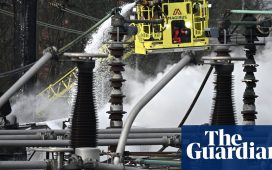There are precious few sectors in which the UK has an advantage nowadays. Carbon capture and storage — unpopular though it may be — is one of them. The country should avoid blunting this competitive edge.
Despite having one-third of all the potential carbon storage capacity in Europe, according to a government-commissioned report, the UK’s record in developing CCS has been abysmal. The technology, which involves removing carbon dioxide from fossil fuels — or indeed the air — and sequestering it underground, has over the years been the subject of broken manifesto promises, cancelled competitions and missed deadlines.
No wonder the UK’s new £20bn support scheme has been tepidly received, in some quarters. The government really should try to inject more fizz into this market.
The world needs it. Sweeping the unwanted consequences of fossil fuels under a (geological) carpet is a poor second best to actually developing green energy sources. But renewable electricity cannot power every sector of our economy. While there is much to dislike in CCS, catastrophic global warming is surely worse.
On top of that, developing CCS is a good way for the UK to attract investment to traditional manufacturing industries, which would otherwise have no place in a net zero strategy. There are no alternative technologies to capture the emissions of cement-making, for instance. Plus it isn’t easy to switch other industries, such as those which require high heat, to electricity.
Currently, companies pay a carbon price for the CO₂ they emit. But having line of sight on a long-term solution would make them happier to put money to work.
The UK’s abundance of potential storage capacity also means it might be able to sell carbon storage as a service. A strategic ambition to become the dustbin of Europe may not sound all that exciting, in PR terms. But it would provide an interesting revenue opportunity.
So, how might the UK nudge this market along?
Some financial support is needed, but for once the cash-strapped Treasury may have pencilled in the right sort of amount: £20bn over 20 years. That may not sound wildly impressive, but rising carbon prices mean that CCS is almost competitive already.
Depending on the sector, capturing, transporting and storing CO₂ may cost somewhere between £60 and £140 per tonne. Companies in the UK currently pay some £75-80 for every tonne of carbon they emit. That means the UK government would only need to provide a smallish top-up — likely via contracts for difference — to enable emitters to press the button on large-scale investments.
How big a top-up, exactly, is currently under negotiation. But say it was £50 per tonne on average. A really rough, back-of-the-envelope calculation suggests the subsidy could fund 20 million tonnes of carbon capture a year. For reference, the UK wants to capture 20-30mn tonnes of CO₂ per annum by 2030.
On top of that, an interesting suggestion, contained in MP Chris Skidmore’s review of the UK’s progress on net zero, is to impose an obligation on oil companies to capture and store 10 per cent of the carbon in their products. That’s extra CCS volumes which they, presumably, would pay for.
Perhaps more concerning is the government’s approach to implementing CCS. It has quite rightly taken a view that it should be developed in regional clusters, which enables sharing of the cost of the transport and storage infrastructure.
But it took a year to narrow the choice of “Track-1” clusters down to two — the East Coast Cluster, where the infrastructure project is led by BP and Equinor, and the HyNet North West cluster led by Italy’s Eni. It then took a further 15 months to work out which projects might connect to each cluster. After producing a long list in August, the shortlist is awaited with bated breath next week.
After that will come bilateral negotiations between the government and each emitter to figure out specific contracts. The economics of the cluster will depend how many projects share the infrastructure cost, so if any fall by the wayside, others will presumably need to be brought up to speed.
That sounds like a potentially lengthy process — just when time is running short. The real hurdle to the development of carbon capture may not be the technical challenges involved, or even the cost of the technology. It might be getting all the cogs in the system to turn at the same time.
Climate Capital

Where climate change meets business, markets and politics. Explore the FT’s coverage here.
Are you curious about the FT’s environmental sustainability commitments? Find out more about our science-based targets here










